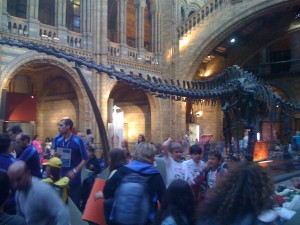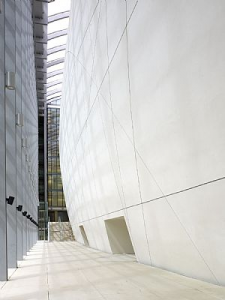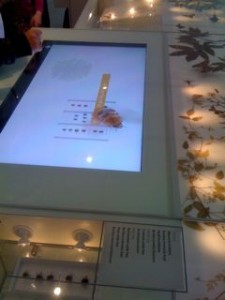 I am not sure how many times I have been to the Natural History Museum. it must be quite a few but this time it was going to be different. For a start we arrived over an hour after it closed to the public with sleeping bags, a picnic and 5 very excited children. Dinosnores as the Natural History museum sleep over is called is run once a month and requires pre booking, quite a lot of pre booking as it turns out. There are the various forms that need to be signed by the parents of the children you are taking and a fair bit of planning about what you will take.
I am not sure how many times I have been to the Natural History Museum. it must be quite a few but this time it was going to be different. For a start we arrived over an hour after it closed to the public with sleeping bags, a picnic and 5 very excited children. Dinosnores as the Natural History museum sleep over is called is run once a month and requires pre booking, quite a lot of pre booking as it turns out. There are the various forms that need to be signed by the parents of the children you are taking and a fair bit of planning about what you will take.
Although we ate just before we arrived we packed a snack (as requested) for the evening, sleeping bags, wash bag and a change of clothes for everyone. We arrived at the Darwin Centre Entrance at 7pm and began to get a sense of the scale of the evening. We were met by museum staff who organised our group into a larger group of about 40, distributed pre printed name badges and led us into a briefing of the nights activities. From there we were led into the main hall where we made camp along with the 500 other campers. It was at this point you got a feel for the scale of the evening – I had up to this point, imagined it as a few kids and grown ups, camped around the large Dinosaur in the main hall. The reality was altogether much more impressive.
The hall was filled with sleeping mats not just in the main area of the hall but up the stairs and into the gallery. Even Darwin had company as he look down on the multitude. The first activity of the evening was to use Lyme Regis clay to paint a gigantic fossil montage with fingers – a cleverly thought out activity as it calmed everyone down including over excited adults like me. After that it was time for a snack followed by a torch lit ‘Guess the Dinosaur trail’ All the while we were shepherded by museum staff who struck exactly the right balance between keeping us all nicely in line without at any time being overbearing. The result was that we were all really relaxed and receptive for a lecture on poisonous and venomous bugs from 10:30 – 11pm. Yes that’s right 250 8 – 14 year olds switched on to a lecture on invertebrates and when I say switched on I mean it. One kid in front of us described how honey bees Kill invading Hornets ( they cook then to death), all way past bedtime.
If you have never been to the Natural History Museum then you won’t know that the original building is a cross between a cathedral and a railway station. if you have been there you might remember the statue of Charles Darwin. It was moved a few years ago and now looks down on the main hall from the staircase. So after 500 people brush their teeth we all lie down and look up at the vaulted ceiling embellished with monkeys, to our right is a Diplodocus to our left Darwin looks down in thought… and then the lights go out. within a minute there is quiet – quiet enough to hear the last tube rumbling way below the museum. I can’t say that I had the best night sleep ever but it was not nearly as bad as I feared it might be.
By Five people were surfacing albeit quietly and by six we were all awake and ready for breakfast (free for the Kids) they managed to tuck in two more events, the first given by a very funny entomologist and the second by a guy who had a nice collection of animals and a good line in banter. We were then free to go off and explore the museum before the ordinary punters traipsed in at 10 in the morning.
This was a great experience for grown-ups and Kids alike and well worth the lost sleep!

 The exhibits included static displays, live demonstrations, video, interactive tables, and combinations of all three. One exhibit was a recreation of the preparation needed for an Expedition in the field this used Video and interactive table a Camera – to take you picture and a function to send your ‘expedition post card’ by email. All very cool and engaging.
The exhibits included static displays, live demonstrations, video, interactive tables, and combinations of all three. One exhibit was a recreation of the preparation needed for an Expedition in the field this used Video and interactive table a Camera – to take you picture and a function to send your ‘expedition post card’ by email. All very cool and engaging.